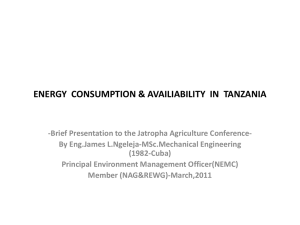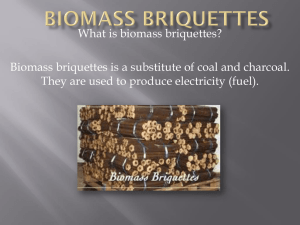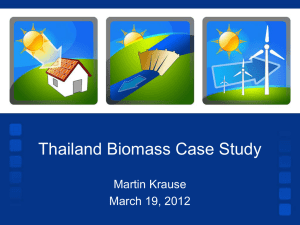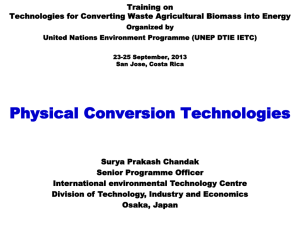Lecture10,11
advertisement
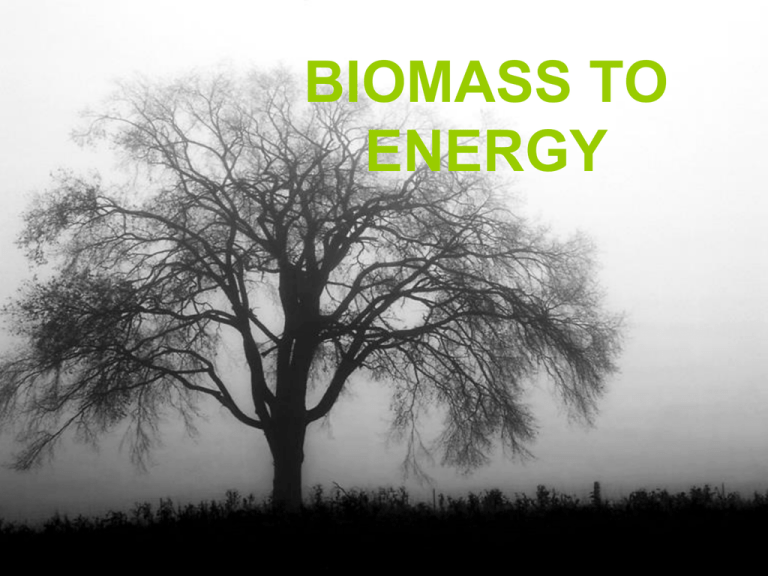
BIOMASS TO ENERGY What is meant by Biomass • Materials produced by metabolic activities of biological systems (plants and animals) and/or products of their decomposition or conversion • The materials are based on carbon compounds • The chemical and energetic value of those materials is based on the carbon-carbon and carbon-hydrogen bond • Biomass suitable for utilization must have a net heating value • Biomass is infact collected and stored solar energy Sources of Biomass • agriculture • residues from forestry, specific industries (e.g. furniture production, saw dust), food processing • solid municipal and industrial wastes • used wood e.g. from old furniture, used timber • marine systems: the oceans of our world contain much more biomass than existing on the continents (but they are not regarded as a source of biomass for energetic utilization) Sources of Biomass • Bio Mass from cattle manure, agricultural waste, forest residue and municipal waste. • Anaerobic digestion of livestock wastes to give bio gas • Fertilizers as by product. • Average electricity generation of 5.5kWh per cow per day!! Carbon Neutral • Energy is produced from biomass by basically burning organic matter to release its stored chemical energy that it has accumulated through the process of photosynthesis. Using biomass contributes very little to the build-up of greenhouse gases. Although plants will release their stored carbon dioxide (CO2) when burned, that CO2 is recaptured and used by other plants as they grow. Therefore, theoretically there is no net gain of carbon dioxide because of a cycle of usage Bio Mass: contribution in Energy • Biomass already supplies 14 % of the world’s primary energy consumption. On average, biomass produces 38 % of the primary energy in developing countries. • USA: 4% of total energy from bio mass, around 9000 MW • INDIA is short of 15,000 MW of energy and it costs about 25,000 crores annually for the government to import oil. Biomass Utilization & Conversion • • • • • Densification Microbial treatment Thermal treatment Chemical treatment Mechanical processes Densification BIOMASS DENSIFICATION is the process of compacting low a bulk density material into a product of high density Densification has stimulate a great deal of interest worldwide in recent years as a technique of beneficiation of residues for utilization as energy source. Densified biomass is mostly in the form of briquettes in developing counties and in the form of pellets in developed countries. • Briquettes Briquetting is the process of densification of biomass to produce homogeneous, uniformly sized solid pieces of high bulk density which can be conveniently used as a fuel. • Pellets Pelletizing is closely related to briquetting except that it uses smaller dies (approximately 30 mm) so that the smaller products are called pellets. Briquettes • Piston Press In the die and punch technology, which is also known as ram and die technology, biomass is punched into a die by a reciprocating ram with a very high pressure thereby compressing the mass to obtain a compacted product. The standard size of the briquette produced using this machine is 60 mm, diameter. The power required by a machine of capacity 700 kg/hr is 25 kW. The ram moves approximately 270 times per minute in this process. Piston Press Briquettes Screw Press In this process, the biomass is extruded continuously by one or more screws through a taper die which is heated externally to reduce the friction. Here also, due to the application of high pressures, the temperature rises fluidizing the lignin present in the biomass which acts as a binder. The outer surface of the briquettes obtained through this process is carbonized and has a hole in the centre which promotes better combustion. Standard size of the briquette is 60 mm diameter. Screw Press Pellets • Flat/disk Type • The flat die type features a circular perforated disk on which two or more rollers rotate. The ring die press features a rotating perforated ring on which rollers press onto the inner perimeter. Large capacity pelletizers are available in the range of 200 kg/h to 30 ton/h thus pellets press capacity is not restricted by density of the raw material as in the case of piston or screw presses. Power consumption falls within the range of 15 – 40 kWh/ton. Flat/disk Type Microbial Treatment • Long traditions in many cultures in the field of food processing e.g. beer brewing, alcoholic fermentation, preservation technologies as lactic acid fermentation • Waste treatment in agriculture and food industry by aerobic treatment (composting) and anaerobic fermentation • Treatment of municipal and industrial waste water • (Pre)Treatment of solid waste containing organic materials Aerobic Processes Agricutural wastes: Treatment of solid Traditional method: urban waste: composting Technology with good prospects Pretreatment of hazardous waste Treatment of gaseous phases for de-odorizing (e.g. compost filters in fish industry) Biomass contributions to energy supply : electrical energy • • • • Wood, other biomass (Combustion, Pyrolysis) Biogas Waste, sewage sludge (incineration, Fermentation) Chemical Processes: hydrogenation, transesterification • BTL (Biomass to liquid) Wood Incineration units • Normally chopped wood or chopped woody residues are used as feeding materials for large cogeneration plants • For the heating of households pelletised materials are available. By using them the incineration process can be operated automatically. The cost for the pelletized wood in relation to mineral oil come to about 2/3 19.5 MW – Plant for gerating heat and electricity in Germany • • • • Input „fresh“ and old wood chops, 5.33 t/h max Steam production: 25.5 t/h Operation 8000 hours per year Energy output electrical from 3.8 to 5.1 MW depending on heat delivery for the households • Energy output thermal: maximum 10 MW Wood – a big potential of the forests • In Germany there are growing about 60 millions of m3 wood per year, that can be harvested • Thats is an energtic equivalent of about 1.5 TWh/a • Compared to the actual energy consumtion of Germany this is a potential of 50% • Actual energetic utilization of wood comes to 0.09 TWh/a Wood burning in stoves • Domestic heating with wood is still by far the largest market for bio-energy • Dramatic improvements of technology in domestic heating equipment • Improved tiled stoves, advanced logwood boilers, woodchip boilers, pellet boilers and pellet stoves. • Pourable wood-based fuel is also available Tiled stoves Pellet Boilers and Stoves Logwood boiler Woodchip boilers Energy content of wood based substrates average data water content calorific value oil equivalent (%) (kWh/kg ) L oil/m3 Pieces 20 4 165 Pellets 10 5 325 Chops 20 4 100 Saw dust 40 2.6 70 ----------------------------------------------------------------------------------------------Wheat 15 4 400 L/1000 kg Pyrolysis Heating in the absence of air. Pyrolysis of biomass generates three different energy products in different quantities: coke, gas and oils. Conversion of solid fuels into combustible gas mixture (CO + H2 + CH4) TYPES • Fluidized-bed fast pyrolysis • Microwave-assisted pyrolysis • Slow pyrolysis • Intermediate pyrolysis Pyrolysis: Advantages It can achieve significantly higher electrical efficiencies (22 % to 37 %) compared to biomass combustion technologies with steam generation and standard turbine technology (15 % to 18 %). The improved electrical efficiency of the energy conversion via pyrolysis naturally means that the potential reduction in CO2 is greater than with combustion. The formation of NOx compounds can also be greatly reduced and the removal of pollutants is generally in most cases. For power plants with integrated biomass gasification in the range 3 to 20 MW electricity, fluidized bed gasification of biomass under atmospheric pressure, coupled with gas turbines using the Cheng cycle or gas and steam turbines appear to be the most promising technology at present in technical and economic terms. For combined heat and power stations with capacities up to about 2 MW electricity, gas use in gas-fired engines is, at the moment, more attractive than gas turbines. What is a Biogas Plant • Basically Methane & CO2 Gas Producer. • Methane – Odorless, Colorless, Good Calorific Value, Green House Gas • Sources : Animal Manures, excreta, kitchen waste, Industrial Chemical Processes, Sea Water Bed, etc. • Animal Manure & Excreta contributes around 16 % of the total global methane emission. Schematic of a typical Biogas Plant Anaerobic Digestion: Biogas Production process MAIN STEPS • Collection and (pre)treatment • Producing a slurry with balanced composition (e.g. watercontent, total organic solids. C/N ratio) • Feeding of reactor with constant rate • Keeping fermenter at nearly constant temperature of about 33o Centigrade • Mixing of substrate during fermentation • Gas collection, purification, utilization (heat and electricity) • Collection and utilization of fermented slurry e.g as high value organic fertilizerer Applications Power Generation Thermal Applications o Irrigation Pumping o Hot Air Generators o Village Electrification o Dryers o Captive Power (Industries) o Boilers o Grid-fed Power from Energy Plantations on Wastelands o Thermic Fluid Heaters o Simultaneous Charcoal and Power Production o Furnaces & Kilns o Ovens Biogas Plants Collection and pretreatment Fermentaion Gas and slurry utilization Anaerobic Digestion of Sewage Sludge Sewage sludge is fermented and used to cover the energy demand of the waste water treatment plants. By doing this those plants need no external energy. The biogas is used for cogeneration of heat for the digesters an electricity for the aerobic waste water purification process (energy for pumping and aeration of the waste water). Waste Incinration: Composting Composting is a traditional technology in agriculture and gardening. Today there are processes of treatment of municipal waste which make use of the heat of composting for drying the solid waste before separation under investigation. There is no significant contribution to the enegy supply of Germany by composting of biomass. Composting of mixtures of municipal and organic waste of food industry is implemented in many cities Technology • Biomass technology today serves many markets that were developed with fossil fuels and modestly reduces their use • Uses - Industrial process heat and steam, Electrical power generation, Transportation fuels (ethanol and biodiesel) and other products. • Primary focus of the Biomass Program – development of advanced technologies. Bio-refinery • A facility that integrates biomass conversion processes and equipment to produce fuels, power, and chemicals from biomass. • Analogous to today's petroleum refineries • It is based on the “Sugar Platform“ and the “Thermochemical Platform“ Modified Waste Vegetable Fat • Designed for general use in most compression ignition engines . • The production of MWVF can be achieved in a continuous flow additive process. • It can be modified in various ways to make a 'greener' form of fuel Environmental Concerns • Air Pollution • Soil Deterioration Air Concerns • Biomass processing technologies have the potential to increase emissions of ozone precursors o Increase in Nox emissions •Emission of relatively large sized particulate matter Soil Concerns • Burning biomass deprives local eco-systems of nutrients • Production of dedicated energy crops renders land fallow • Reduced land availability for cattle grazing •Increased use of pesticides and fertilizers to produce energy crops contaminate ground and surface water o Affects fish and wildlife Environmental Benefits •Reduction of waste • Extremely low emission of greenhouse gases compared to fossil fuels •Carbon neutral and forms a part of the carbon cycle • Growing variety of crops increases bio-diversity Future The future development will be based on increasing production of energy crops, optimized utilization of organic residues and on thermalchemical treatment of organic matter to produce gaseous and liquid fuels. There are lot of estimations for future contributions of biomass to energy supply, they will come to at least 20 or 30 percent until 2020.





